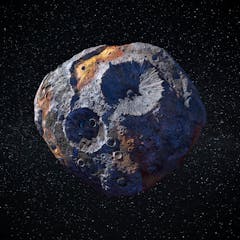
Articles on Earth's core
Displaying 1 - 20 of 27 articles

The Moon was formed when it collided with Earth billions of years ago.

Upcoming NASA missions will help scientists understand the composition of asteroids – which could inform companies one day hoping to commercially mine asteroids.

A distant lump of space rock may have a surprising amount in common with the core of our own planet.

Liftoff to the distant asteroid is scheduled for Oct. 5, 2023 – the beginning of a six-year journey to one of the most unusual objects in the solar system.

Scientists were not previously certain how the precious stones arrived at the Earth’s surface.

The Earth isn’t permanent, but it was here for four billion years before humans arrived and should be here for several billion more.

Earth doesn’t just have an inner core. It also has an innermost inner core, a solid ball within the solid ball in the very middle of the planet.

Starting at the surface, you would have to dig nearly 2,000 miles before reaching the Earth’s core. No one could survive that trip – and the 10,000-degree F heat once there would vaporize you anyway.

Could tectonic processes in the early Earth have contributed to the rise of oxygen?

Geology experts explain why coloured diamonds are so much rarer than clear ones – and why the newly discovered Lulo Rose might become the most expensive diamond in history.

This is a really important question, and one which climatologists work on in many aspects of their jobs.

8,000 tonnes of molten iron solidifies in Earth’s inner core every second – but it’s not distributed equally.

The rocks provide rare evidence of a time when Earth’s surface was a deep sea of incandescent magma.

The updated methods are providing a clearer picture of how Earth and its inhabitants evolved over the past 60,000 years - and thus, providing new insight into its future.

The Earth’s magnetic field is a lot weaker than we would expect around the island of St Helena.

Changes in the Earth’s magnetic field pose a great risk to electronic infrastructure.

Of all the planets in the solar system, there’s a reason we call Earth home. It’s made of just the right stuff. It’s not too small, or too big, or too hot or too cold. It’s just right.

Fossil fuels are heating the atmosphere – but the fact that we’re burning them may not be the only reason.

New findings suggest the core has been leaking for the past 2.5 billion years, and that could help scientists understand how the core was formed.

The Earth’s core is cooling down, and one day it will be completely solid – when that happens, Earth might look a lot like Mars.
